55 Powerful Rainforest Deforestation Statistics
This page contains affiliate links. We may earn money or products from the companies mentioned in this post through our independently chosen links, which earn us a commission. Learn More
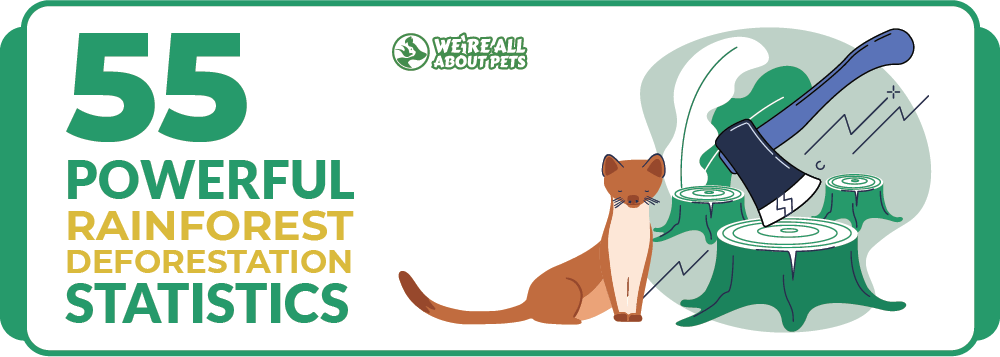
When you hear the word “rainforest” you probably picture a lush stretch of land covered in towering trees. Rainforests can be found all over the world and on every continent except for Antarctica. These forests are essential to our survival, providing a habitat for half the earth’s fauna and producing most of the oxygen we breathe as humans.
The typical rainforest receives over 70 inches of rain per year and most are very warm, having an average temperature of 86°F (30°C) during the day and 68°F (20°C) at night.
Not only do rainforests produce a significant amount of the world’s oxygen but, according to The Nature Conservancy, they house roughly half the Earth’s animal population. A 4-square-mile area (2,560 acres) of rainforest may contain as many as 1,500 different flowering plants, 750 different species of trees, over 400 species of birds, and 150 species of butterfly.
To put it in specific terms, rainforests cover less than 2% of the Earth’s total surface area but house more than 50% of its plants and animals.
Though rainforests are extremely important to human survival, they are under threat by human activity. Deforestation, the conversion of forested land to non-forest land, is an international – even global – issue. The United Nations Food and Agriculture Organization (FAO) estimates that 18 million acres of forest land are lost each and every year.
Check out our powerful rainforest deforestation statistics infographic and keep reading to learn more!
The Top 12 Facts And Statistics About Deforestation
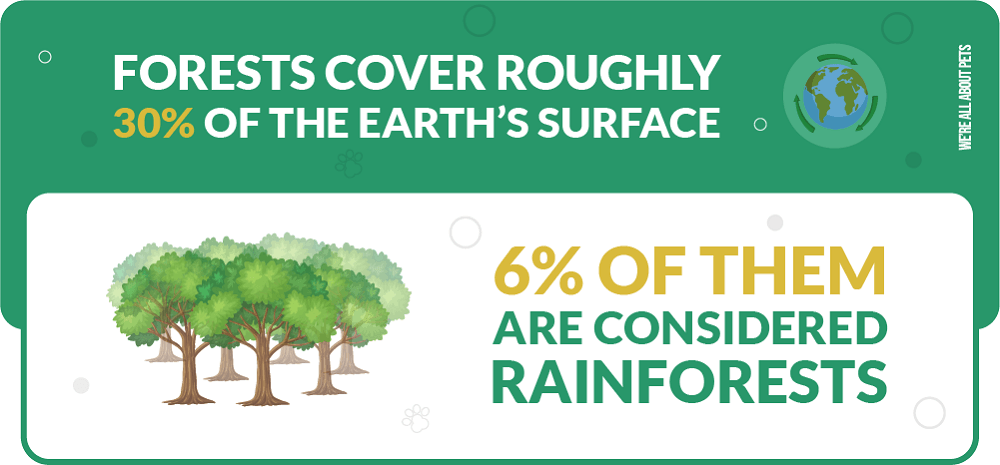
- Forests cover roughly 30% of the Earth’s surface – about 6% of them are considered rainforests.
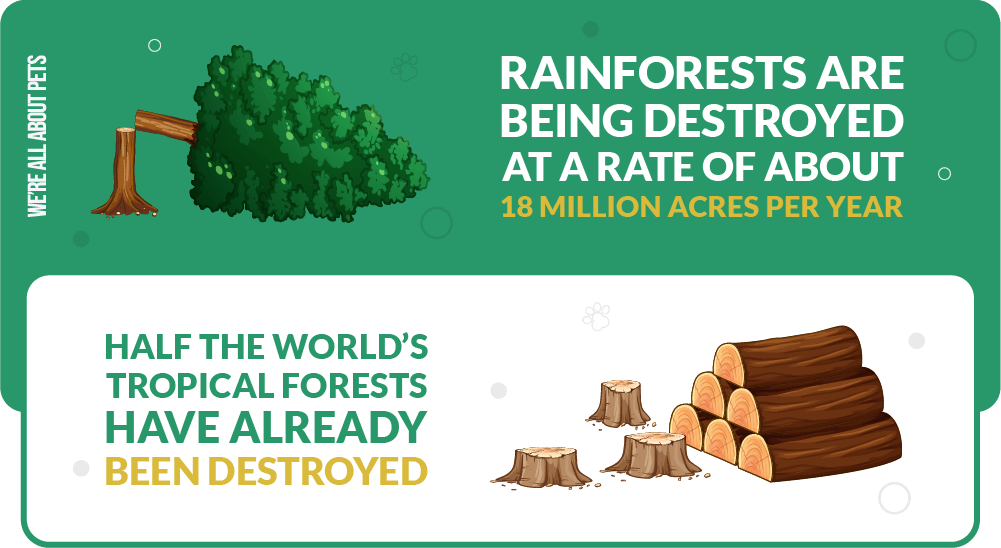
2. Rainforests are being destroyed at a rate of about 18 million acres per year. It is estimated that none will remain within 100 years at the current rate of deforestation.
3. About 1 ½ acres of forest land are destroyed every second – that’s roughly the size of 36 football fields every minute. Agriculture is the leading cause of deforestation.
4. Unsustainable agricultural expansion is the leading cause for 80% of deforestation around the world.
5. Deforestation contributes somewhere between 12% and 17% of annual global greenhouse gas emissions.
6. The United States accounts for less than 5% of the Earth’s population but consumes over 30% of its paper. The average American uses 700 pounds of paper per year.
7. The Amazon rainforest alone is extremely important. It is the world’s largest rainforest, covering roughly 2.72 million square miles. An estimated 20% of the world’s oxygen is produced in the Amazon rainforest.
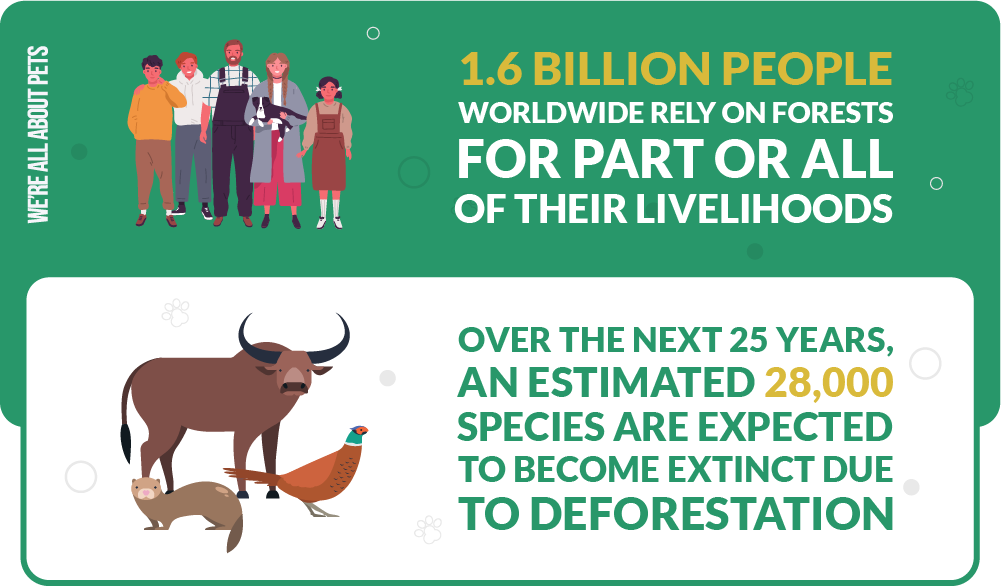
8. Over the next 25 years, an estimated 28,000 species are expected to become extinct due to deforestation.
9. Half the world’s tropical forests have already been destroyed. The primary causes of man-made deforestation are poverty, overpopulation, and unequal land access.
10. More than 1.6 billion people worldwide rely on forests for part or all of their livelihoods.
11. Forest products account for 1% of the world’s GDP. The total global market for commercial wood products is over US $200 billion per year.
12.According to the World Economic Forum, over 30% of the diseases that are emerging in modern times are the result of deforestation.
8 Surprising Rainforest Facts And Statistics
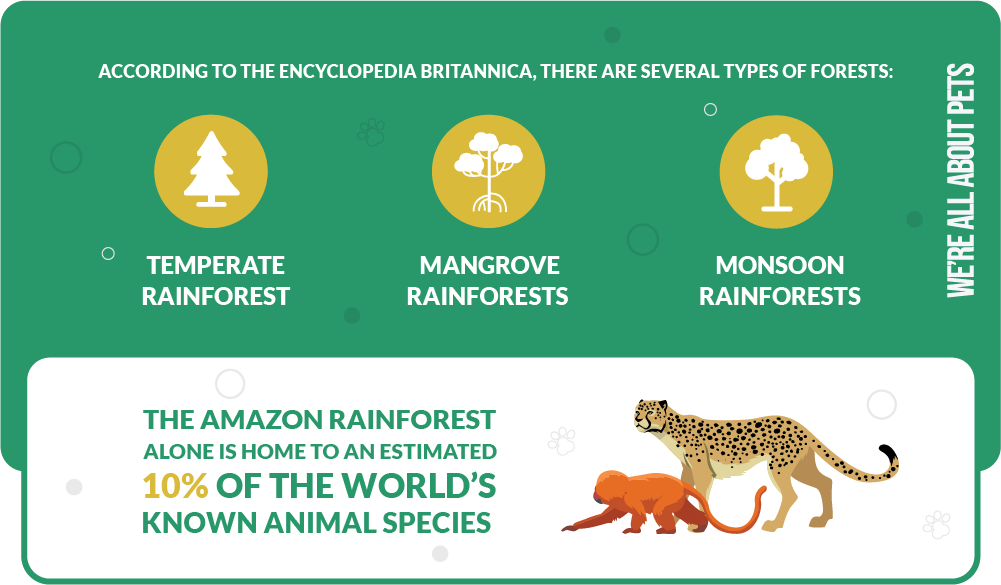
- According to the Encyclopedia Britannica, there are several types of forests:
- Temperate Rainforest – These are found in temperate zones and consist of coniferous or broadleaf trees.
- Mangrove Rainforests – Made primarily of mangrove trees, these grow only in brackish waters where rivers meet the ocean.
- Monsoon Rainforests – Also called “dry rainforests,” these rainforests have a dry season. Up to 75% of the trees in monsoon rainforests can be deciduous.
- The average temperature range in a rainforest is 86°F (30°C) during the day and 68°F (20°C) at night.
- Rainforests are made up of two primary areas: the canopy and the understory. The canopy is the top of the rainforest which can reach 98 to 164 feet high. The understory is primarily made up of ferns, flowers, tree trunks, and dead leaves.
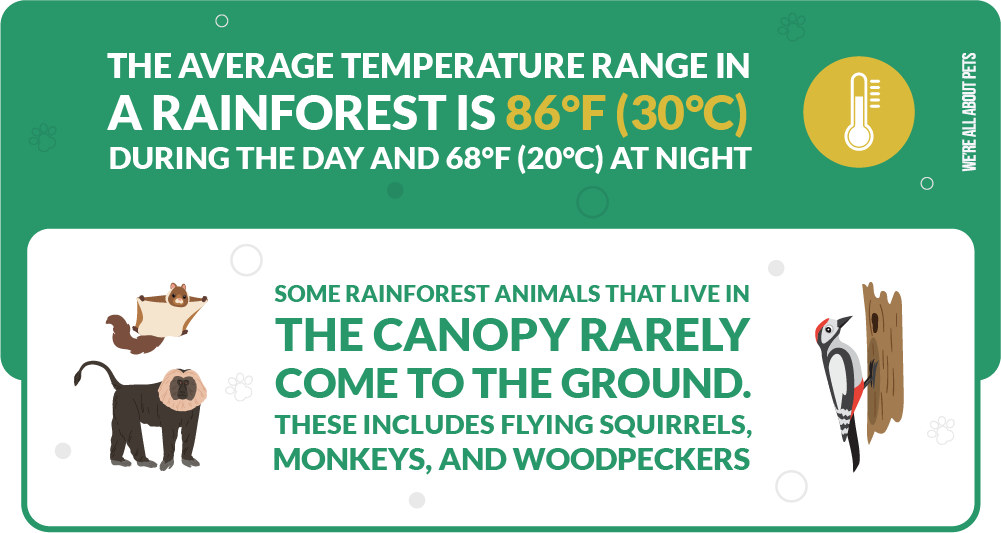
4. Some rainforest animals that live in the canopy rarely come to the ground. These includes flying squirrels, monkeys, and woodpeckers.
5. A 4-square-mile area (2,560 acres) of rainforest may contain as many as 1,500 different flowering plants, 750 different species of trees, over 400 species of birds, and 150 species of butterfly.
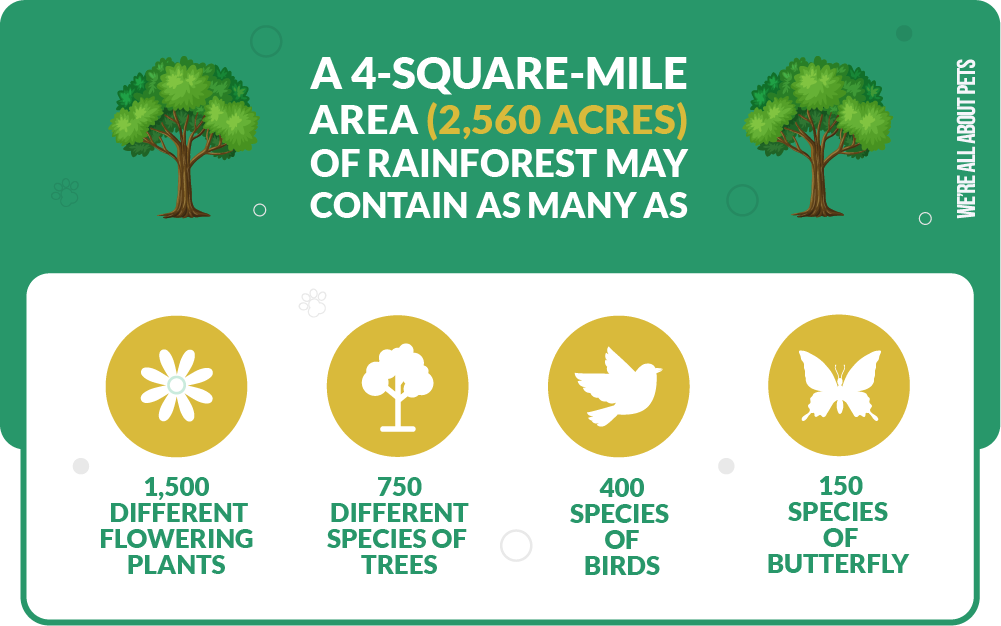
6. The Amazon rainforest alone is home to an estimated 10% of the world’s known animal species.
7. Animals of nearly every type live in rainforests. You may be surprised to learn that deer, rhinoceros, chimpanzees, elephants, and even bears live in rainforests.
8. The Amazon rainforest is estimated to have 390 billion individual trees from 16,000 species.
10 Facts About Rare Rainforest Plants And Animals
- The fairy lantern parasite (Thismia neptunis) was first documented over 150 years ago and has only been documented once since, in 2018. This plant feeds on underground fungi and doesn’t require sunlight to survive.
- The tapir, an animal that looks like a cross between an anteater and a pig, is found in the rainforests of South America and Asia.
- The African rainforest is home to the forest giraffe or okapi, a four-legged animal that looks like a cross between a horse and a zebra.
- The rainforest is home to the world’s largest spider, the South American Goliath birdeater (Theraphosa blondi) which can weigh up to 6 ounces. Each of its legs can grow up to 1 foot long.
- Rainforests are home to 70% of the plants identified by the U.S. National Cancer institute as having cancer-fighting properties. Though only 1% off tropical rainforests have been analyzed for their medicinal value, scientists have identified over 2,000 tropical plants with anti-cancer properties.
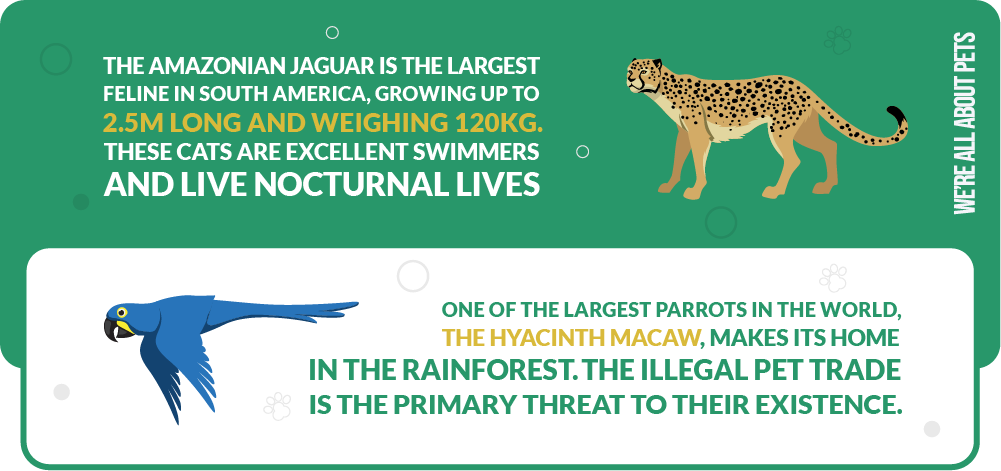
6. The Amazonian jaguar is the largest feline in South America, growing up to 2.5m long and weighing 120kg. These cats are excellent swimmers and live nocturnal lives.
7. The golden lion tamarin is a small species of monkey endemic to the rainforests of Brazil. These monkeys weigh less than 800 grams and are named for their bright orange manes.
8. The Amazon rainforest is home to giant otters that grow up to 1.7m long. These otters can be found in the waterways that run through the rainforest, acting as a primary predator in aquatic ecosystems.
9. The Uakari monkey, named for the Uakari tribe that once lived in the Amazon, has a bright red face. These monkeys are considered a vulnerable species due to poaching and deforestation.
10. One of the largest parrots in the world, the hyacinth macaw, makes its home in the rainforest. These birds come in rich greens and blues and grow up to 40 inches in length. The illegal pet trade is the primary threat to their existence.
The Importance Of Rainforests By The Numbers
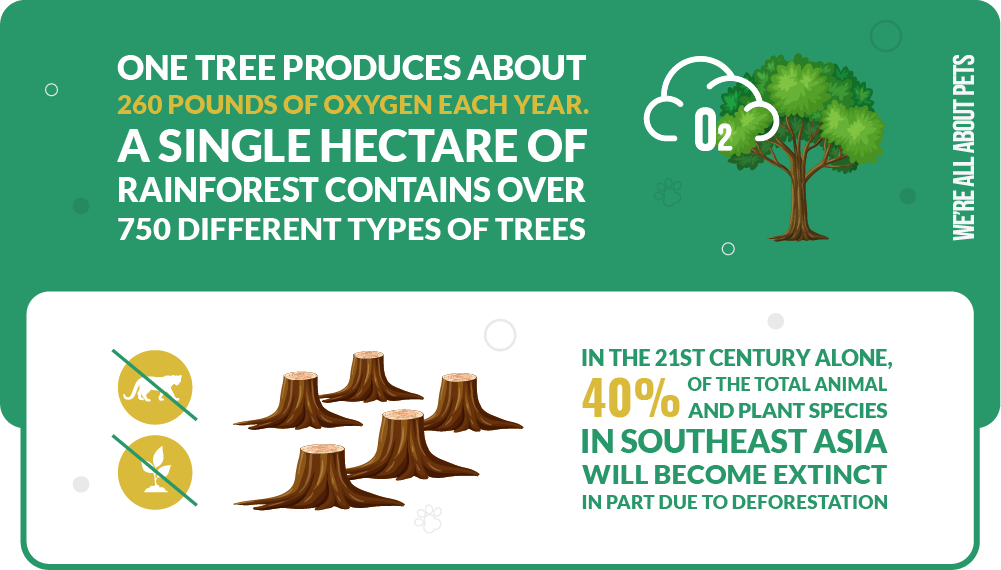
- One tree produces about 260 pounds of oxygen each year. A single hectare (about 2.5 acres) of rainforest contains over 750 different types of trees.
- Trees absorb carbon dioxide to grow but, when they are cut down, they release all the stored carbon dioxide. It is estimated that dead Amazonian rainforest trees release 1.9 billion tons of carbon dioxide into the atmosphere each year. Those trees, when they are alive, absorb 2.2 billion tons of carbon dioxide.
- Of the original 6 million square miles of tropical rainforest that once grew on Earth, only about 2.4 million square miles remain.
- According to The Nature Conservancy, only about 50 percent of temperature rainforests (about 75 million square acres) still exist.
- The primary reasons for forest loss are ranching, mining, logging, and agriculture. Between 2000 and 2012, over 720,000 square miles of forest were lost – that’s the same size as all the United States east of the Mississippi River.
- Around the world, deforestation decrease the global flow of water vapor from the land by 4%. This change can disrupt climates and weather patterns.
- Research reveals that precipitation levels have decreased significantly in deforested areas of north and northwestern China. Between the 1950s and 1980s, precipitation levels dropped by one-third.
- Indonesia was the country with the highest rate of deforestation between 2000 and 2012 – they lost roughly 15 million acres of forest during those years.
- Estimates state that deforestation leads to a loss of 137 species of plants, birds, and animals every day. That amounts to roughly 50,000 species per year.
- It has been predicted that in the 21st century alone, about 40% of the total animal and plant species in southeast Asia will become extinct in part due to deforestation.
15 Facts And Statistics About The Amazon Rainforest
- The Amazon rainforest is the world’s largest rainforest – it is larger than the next two rainforests combined (Indonesia and the Congo basin).
- Covering about 40% of the South American continent, the Amazon rainforest is roughly the size of the 48 contiguous United States. It covers 6.9 million square kilometers (2.72 million square miles).
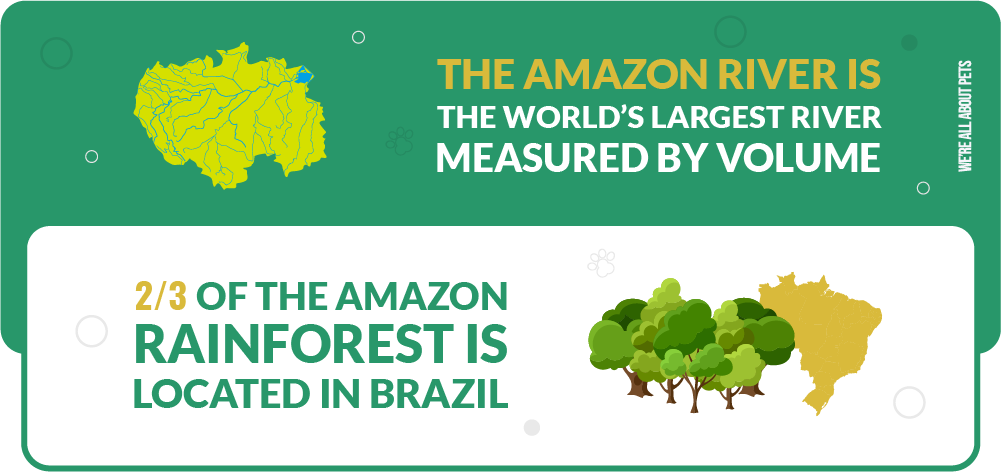
3. The Amazon River is the world’s largest river measured by volume. It carries five times the volume of the Congo and twelve times the volume of the Mississippi.
4. The actual length of the Amazon is a matter of some dispute, largely due to differences in opinion regarding where it originates. A U.S. Geological Survey puts the total length around 4,000 miles (6,437 km), making it second in length to the Nile River in Egypt (4,132 miles).
5. The Amazon River drains an area roughly the size of the 48 contiguous United States. It contains over 15,000 tributaries, some of which measure over 1,000 miles long.
6. Nearly two-thirds of the Amazon rainforest is located in Brazil.
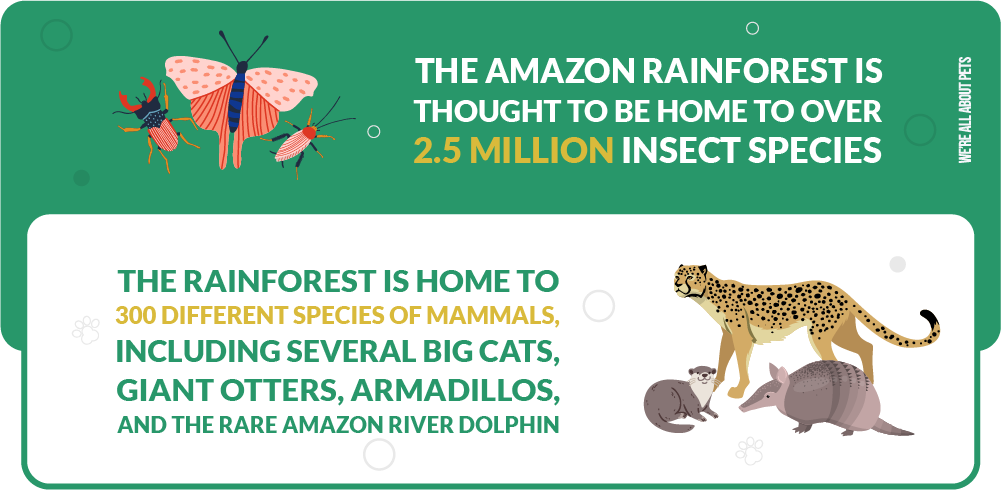
7. The Amazon rainforest is thought to be home to over 2.5 million insect species, more than half of which live in the canopy.
8. Each year, the Amazon rainforest receives an average of 9 feet of rain.
9. During the rainy season, the Amazon River’s level may rise as high as 30 to 45 feet. The rainy season lasts from mid-December to mid-May.
10. The Amazon River releases approximately 7,400,000 cubic feet of water into the Atlantic Ocean each second. This swells to 11,000,000 cubic feet per second in the rainy season.
11. The Amazon Basin (which includes all of the areas drained by the Amazon River) covers nearly 2.9 million square miles. It encompasses 40% of South America, including parts of eight countries – Bolivia, Brazil, Colombia, Ecuador, Guyana, Peru, Suriname, and Venezuela.
12. Thanks in part to the biodiversity of the Amazon region, Peru is home to the third-largest number of mammals in the world.
13. The rainforest is home to 300 different species of mammals, including several big cats, giant otters, armadillos, and the rare Amazon River dolphin.
14. There are about 150 different species of monkeys in the Amazon rainforest. This includes 15 types of tamarin, 9 howler monkey species, and a number of unusual species like the bald uakari and the nocturnal night monkey (owl monkey).
15. The Amazon is home to 1,500 species of amphibians. In some areas you can find as many as 80 species of frog in a single small section of rainforest.








